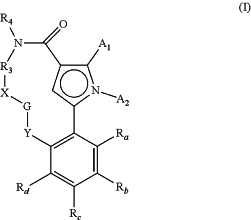| CPC A61K 31/675 (2013.01) [A61K 31/4748 (2013.01); A61K 31/5377 (2013.01); A61K 45/06 (2013.01); A61P 35/02 (2018.01); C07D 498/18 (2013.01); C07D 498/22 (2013.01); C07F 9/65335 (2013.01)] | 15 Claims |
|
1. A compound of formula (I):
 wherein:
A1 and A2, independently of one another, represent a hydrogen or halogen atom, a linear or branched polyhalo-(C1-C6)alkyl, a linear or branched (C1-C6)alkyl group or a cycloalkyl group,
or A1 and A2, together with the atoms to which they are attached, form an aromatic or non-aromatic heterocycle Het composed of 5, 6 or 7 ring members, which optionally has, in addition to nitrogen, from one to 3 hetero atoms selected independently from oxygen, sulphur and nitrogen, wherein the nitrogen in question is substituted by a hydrogen atom, a linear or branched (C1-C6)alkyl group or a group —C(O)—O-Alk, wherein Alk is a linear or branched (C1-C6)alkyl group,
G represents —NR7—, a 1,2,3,4-tetrahydroisoquinolinylene group optionally substituted by a group T, a 2,3-dihydro-1H-isoindolylene group optionally substituted by a group T, or a piperidinylene group,
T represents a hydrogen atom, a linear or branched (C1-C6)alkyl optionally substituted by from one to three halogen atoms, a (C1-C4)alkyl-NR1R2 group, or a (C1-C4)alkyl-OR6 group,
X represents a (C2-C8)alkylene group in which from 1 to 3 carbon atoms are optionally replaced by a hetero atom selected from oxygen, sulphur and N—R5, or by an arylene or heteroarylene group,
Y represents —CH2— or —CO—,
R1 and R2, independently of one another, represent a hydrogen atom or a linear or branched (C1-C6)alkyl group,
or R1 and R2, together with the nitrogen atom to which they are attached, form a heterocycloalkyl,
R3 and R4 are such that:
one of them represents a phenyl group of the following formula:
 wherein W represents a hydroxy group or a phosphate group selected from —OPO(OM)(OM′), —OPO(OM)(O−M1+), —OPO(O−M1+)(O−M2+), —OPO(O−)(O−)M32+, —OPO(OM)(O[CH2CH2O]1CH3) and —OPO(O−M1+)(O[CH2CH2O]nCH3), wherein M and M′ independently of one another represent a hydrogen atom, a linear or branched (C1-C6)alkyl group, a linear or branched (C2-C6)alkenyl group, a linear or branched (C2-C6)alkynyl group, a cycloalkyl or a heterocycloalkyl, both the cycloalkyl and heterocycloalkyl being composed of from 5 to 6 ring members, M1+ and M2+, independently of one another, represent a pharmaceutically acceptable monovalent cation, M32+ represents a pharmaceutically acceptable divalent cation and n is an integer from 1 to 5,
and the other represents an aryl, heteroaryl, heterocycloalkyl, cycloalkyl or linear or branched (C1-C6)alkyl group, wherein one or more carbon atoms of the preceding groups, or of their possible substituents, are optionally deuterated,
R5 represents a hydrogen atom or a linear or branched (C1-C6)alkyl group,
R6 and R7, independently of one another, represent a hydrogen atom or a linear or branched (C1-C6)alkyl group,
Ra, Rb, Rc and Rd, independently of one another, represent a hydrogen atom, a linear or branched (C1-C6)alkyl group, a halogen atom, a linear or branched (C1-C6)alkoxy group, a hydroxy group, a linear or branched polyhalo-(C1-C6)alkyl group, a trifluoromethoxy group, or the substituents of one of the pairs (Ra,Rb), (Rb,Rc) or (Rc,Rd), together with the carbon atoms to which they are attached, form a ring composed of from 5 to 7 ring members, wherein the ring optionally has from one to 2 hetero atoms selected from oxygen and sulphur, and wherein one or more carbon atoms of the ring defined hereinbefore is optionally deuterated or optionally substituted by from one to 3 groups selected from halogen and linear or branched (C1-C6)alkyl,
wherein:
“aryl” means a phenyl, naphthyl, biphenyl or indenyl group,
“heteroaryl” means any mono- or bi-cyclic group composed of from 5 to 10 ring members, having at least one aromatic moiety and having from 1 to 4 hetero atoms selected from oxygen, sulphur, nitrogen and quaternary nitrogen,
“cycloalkyl” means any mono- or bi-cyclic, non-aromatic, carbocyclic group containing from 3 to 10 ring members,
“heterocycloalkyl” means any mono- or bi-cyclic, fused or spiro, non-aromatic group composed of from 3 to 10 ring members, which has from 1 to 3 hetero atoms selected from oxygen, sulphur, SO, SO2 and nitrogen,
arylene, heteroarylene, 1,2,3,4-tetrahydroisoquinolinylene, 2,3-dihydro-1H-isoindolylene or piperidinylene mean a divalent aryl, heteroaryl, 1,2,3,4-tetrahydroiso-quinoline or piperidine group,
wherein the aryl, heteroaryl, cycloalkyl and heterocycloalkyl groups so defined and the groups alkyl, alkenyl, alkynyl and alkoxy are optionally substituted by from 1 to 3 groups selected from: linear or branched (C1-C6)alkyl optionally substituted by a hydroxy, morpholinyl, 3,3-difluoropiperidinyl or 3,3-difluoropyrrolidinyl group; (C3-C6)spiro; linear or branched (C1-C6)alkoxy optionally substituted by a morpholinyl group; (C1-C6)alkyl-S—; hydroxy; oxo; N-oxide; nitro; cyano; —COOR′; —OCOR′; NR′R″; linear or branched polyhalo-(C1-C6)alkyl; trifluoromethoxy; (C1-C6)alkylsulphonyl; halogen; aryl optionally substituted by one or more halogen atoms; heteroaryl; aryloxy; arylthio; cycloalkyl; heterocycloalkyl optionally substituted by one or more halogen atoms or linear or branched (C1-C6)alkyl groups; wherein R′ and R″, independently of one another, represent a hydrogen atom or a linear or branched (C1-C6)alkyl group optionally substituted by a methoxy group,
its enantiomers and diastereoisomers, or addition salts thereof with a pharmaceutically acceptable acid or base.
|
|
13. A pharmaceutical composition comprising the compound according to claim 1, or an addition salt thereof with a pharmaceutically acceptable acid or base, in combination with one or more pharmaceutically acceptable excipients.
|